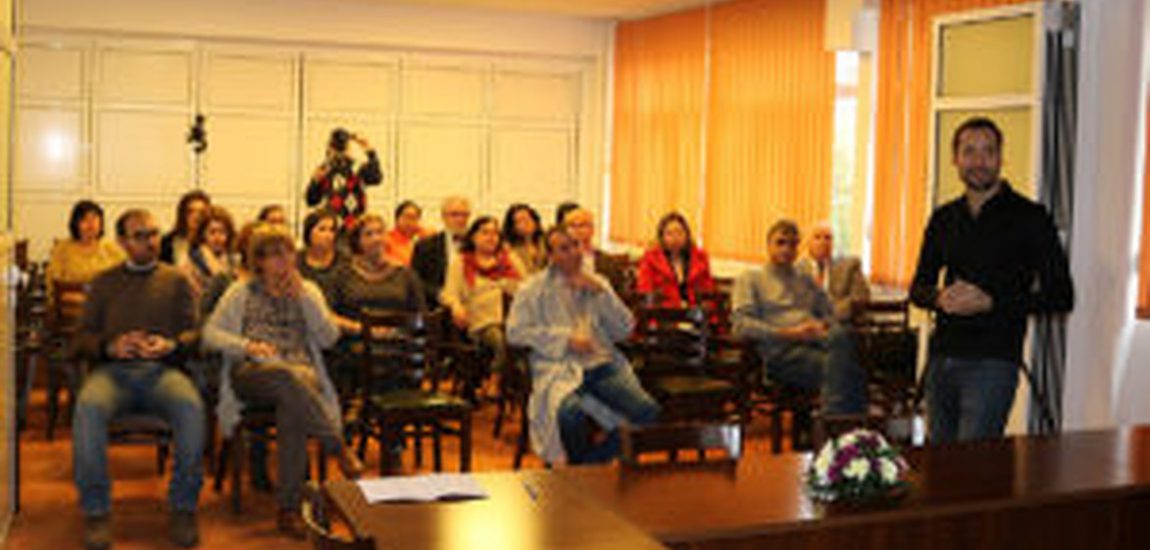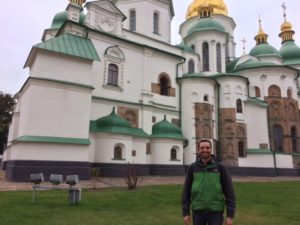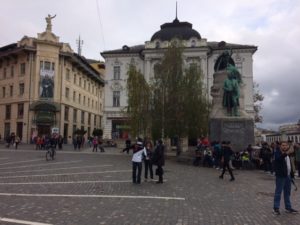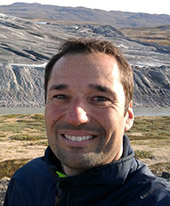
The Great Eastern
I have been really fortunate to be asked to take part of the 2016 EAG Distinguished Lecture Program. My research interests are broad lying on the interface between chemistry and biology and I have always enjoyed interacting with researchers from these disciplines. I am a biologist by background but working on the biogeochemical processes of cold environments. Sometimes, I use biological techniques and sometimes more chemically-oriented approaches to determine the magnitude of carbon and nutrient cycling on glaciers. The tour was an excellent opportunity to interact across the disciplines. I went to specific Institutes that focused on Geochemistry (Kiev and Krakow) and Biology/Microbiology (Bucharest and Ljubljana). For each place, I was aiming for a mission to engage microbiologists with geochemists. On the top of that, it was a great opportunity for me to see a side of Europe that has a rich history. The airline Gods were certainly in favour of the tour. Travelling forth and back to four different destinations in 9 days meant to board on a plane 10 times using about 5 different airline companies in a short period of time. Except for one harmless small delay between Belgrade and Ljubljana, every single flight was bang on time, making the whole trip really smooth.

The first lecture was at the M.P. Semenenko Institute of Geochemistry, Mineralogy and Ore Formation, which is part of the National Academy of Science of Ukraine in Kiev on a Friday. This was my first chance to calibrate the talk to ensure that a predominantly geochemist audience would enjoy some microbiology. Based on the number of questions and interest around, I thought the tour started well. After the lecture, I had a very nice time learning about rocks and the projects running at the Institute. First, there was a tour in the Natural History Museum of the Institute which had one of the most amazing and complete mamuts I have ever seen and a wide range of rocks and minerals. Thereafter, PhD student Tatiana Ilchenko took me for a tour of the city centre of Kiev and I learned a great deal about Orthodox churches. It was my first time in Kiev and certainly very impressive.
Saturday morning, I flew to Bucharest via Warsaw. Bucharest was the place in which I would spend the weekend until Tuesday, so I was quite excited to see the place around. Dr. Cristina Purcarea and her PhD student Antonio Mondini took me to a variety of places and every place just made me more and more dazzled. I was simply speechless during the visit to the Palace of the Parliament and I enjoyed some amazing food too. On Monday, it was time to give two lectures in the Institute of Biology Bucharest, which is part of the Romanian Academy Bucharest. There was a very enthusiastic audience and we had a great and lively discussion throughout the morning and afternoon. I am very grateful here for a gift from Cristina which included a T-shirt with my favourite book character, Dracula.
Tuesday was then time to get to Ljubljana via Belgrade where Prof. Nina Gunde-Cimerman and PhD student Laura Perini took excellent care of me too. I had an absolutely great Slovenian meal, including some very delicate frog meat. The talk was in the Department of Biology at University of Ljubljana containing a very nice mixed audience of academic staff and undergraduate students. We had some very good discussions about the role of fungal communities in cold environments, as this is still an understudied biological component of glaciers in which Prof. Gunde-Cimerman’s lab is doing very exciting work on.
Thursday and Friday, I spent time in Krakow at the Institute of Geological Sciences, Jagiellonian University, hosted by Prof. Marek Michalik and Dr. Monika Kasina and another PhD student. There was a good mix of academics and students working on the interface between geochemistry and biogeochemistry, resulting in really interesting discussions about the role of microbes on rock weathering. Krakow is a very vibrant city with around 100,000 students across several universities, beautiful historic places and lots of nice people. It is one of the oldest cities in Poland and one should not miss the castle and the Jagiellonian University museum.
Because I work in the UK during a period of so much debate created by Brexit, I could hardly stop thinking about the impact that the EU has had on collaborative research across Europe and, in particular, in society and economy of Eastern European countries. I am trying to be neutral, but it was impossible to not notice what Ukraine may gain, what Slovenia and Romania have already gained and what the UK will loose. The young generation in the places I visited are full of hope and very enthusiastic about their work. I am extremely grateful for my hosts to have made my tour so enjoyable and stimulating, but I would certainly like to give special thanks to the young generation of postdocs and PhD students who took excellent good care of me. These are not only nice young people, but very bright rising stars doing extremely interesting work in geochemistry/microbiology. Special thanks to Tatiana, Antonio, Laura and Monika. I must also thank Marie-Aude Hulshoff for all her hard work to sort all the practicalities out, and the EAG for giving me this once-in-a-lifetime opportunity.
The videos of the lectures ‘Biogeochemical cycles and microbial processes in icy habitats’ and ‘The interplay between weathering and microbes during soil formation’ are available at www.eag.eu.com/outreach/dlp/.

About the author

Prof. Alexandre Anesio (University of Bristol, UK) was the EAG 2016 Distinguished Lecturer. Alexandre’s research interests are broad and combine concepts from Geography, Biology and Chemistry to understand carbon cycle in the cryosphere. His research has concentrated in two broad areas. Firstly, he studies microbes in the cryosphere. Against all expectations glaciers harbour a highly active microbial community. Bacteria, viruses and microscopic plants thrive in conditions that might be analogous to other planets and to early Earth. Second, he is also interested in a range of climate (e.g., UV radiation and acid rain) and human impacts (e.g., mining, sewage, pesticides) on freshwaters. Read more
